
Browse an alphabetical list of film clips that feature important events before, during, and after the Holocaust and World War II. These clips include home movies, propaganda films, newsreels, and more.
<< Previous | Displaying results 151-191 of 191 for "Film" | Next >>
The Soviet Union occupied Lvov in September 1939, according to secret provisions of the German-Soviet Pact. Germany invaded the Soviet Union on June 22, 1941. After a week of bitter fighting, German forces occupied Lvov. They discovered that the Soviet Secret Police had massacred thousands of prisoners, mostly Ukrainian nationalists, before fleeing from the city. This footage shows the removal of the bodies of some of those massacred. The Germans claimed that the city's Jewish population had supported the…
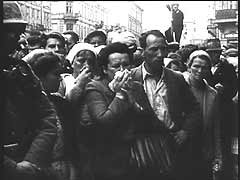
The German ship SS "St. Louis" departed from Hamburg for Cuba with almost 1,000 Jewish refugees on board on May 13, 1939. Most of the passengers had Cuban landing certificates. However, the Cuban government invalidated the certificates. When the "St. Louis" reached Havana on May 27, most of its passengers were denied entry. After the United States also refused to accept the refugees, the ship returned to Europe, docking at Antwerp. Britain, France, Belgium, and the Netherlands then agreed to accept the…
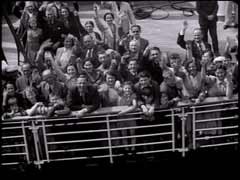
This footage shows German forces entering the Sudetenland. Under the terms of the Munich Pact, Germany annexed this largely German-speaking region from Czechoslovakia. Germany, Italy, Britain, and France were party to the pact, which averted war. Czechoslovakia, however, was not permitted to attend the Munich conference. Hitler later violated the Munich Pact by destroying the Czech state in March 1939.
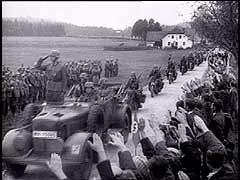
The German western campaign into the Low Countries and France shattered Allied lines. Within six weeks, Britain evacuated its forces from the Continent and France requested an armistice with Germany. Paris, the French capital, fell to the Germans on June 14, 1940. In this footage, triumphant German forces raise the swastika flag over Versailles and over the Eiffel Tower in Paris. Versailles, the traditional residence of French kings, was deeply symbolic for the Germans: it was the site of both the…
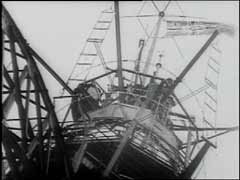
In the Justice Case of the Subsequent Nuremberg Proceedings, nine officials from the German Ministry of Justice and seven members of the Nazi-era People's and Special Courts were charged with “judicial murder and other atrocities, which they committed by destroying law and justice in Germany, and then utilizing the emptied forms of legal process for the persecution, enslavement and extermination on a large scale.” This footage shows US prosecutor Telford Taylor describing the defendants.
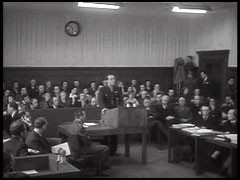
In the Justice Case of the Subsequent Nuremberg Proceedings, nine officials from the German Ministry of Justice and seven members of the Nazi-era People's and Special Courts were charged with “judicial murder and other atrocities, which they committed by destroying law and justice in Germany, and then utilizing the emptied forms of legal process for the persecution, enslavement and extermination on a large scale.” In this footage from the trial, US prosecutor Telford Taylor describes the nature…
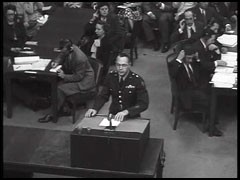
Lieutenant Colonel Baldwin of the US prosecution team presents the case against defendant Hans Frank at the Nuremberg trial. Baldwin refers to several of Frank's diary entries about the appropriation of scarce Polish grain for use as food in Germany.
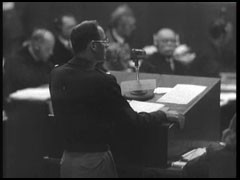
In this video introduction to The Nazi Olympics: Berlin 1936, American Jewish athlete Marty Glickman, US Holocaust Memorial Museum Director Sara J. Bloomfield, exhibition curator Susan Bachrach, and German Jewish athlete Gretel Bergmann reflect and remember the 1936 Olympic Games as more than history.
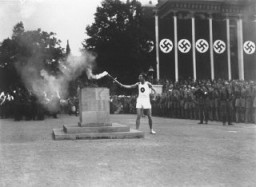
The film "The Nazi Plan" was shown as evidence at the International Military Tribunal in Nuremberg on December 11, 1945. It was compiled for the trial by Budd Schulberg and other US military personnel, under the supervision of Navy Commander James Donovan. The compilers used only German source material, including official newsreels. This footage titled "Hitler Predicts Annihilation of the Jewish Race in Europe if War Occurs" shows Hitler delivering a speech to the German parliament on January 30, 1939.
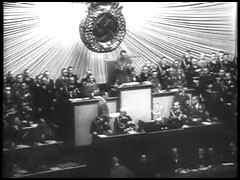
[This video is silent] The film "The Nazi Plan" was shown as evidence at the International Military Tribunal in Nuremberg on December 11, 1945. It was compiled for the trial by Budd Schulberg and other US military personnel, under the supervision of Navy Commander James Donovan. The compilers used only German source material, including official newsreels. This footage is titled "Opening of the Official Anti-Semitic Campaign 1 April 1933."
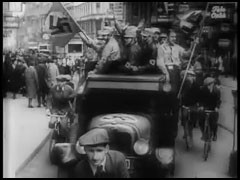
The film "The Nazi Plan" was shown as evidence at the International Military Tribunal in Nuremberg on December 11, 1945. It was compiled for the trial by Budd Schulberg and other US military personnel, under the supervision of Navy Commander James Donovan. The compilers used only German source material, including official newsreels. This footage is titled "The Burning of the Books, 10 May 1933."

The film "The Nazi Plan" was shown as evidence at the International Military Tribunal in Nuremberg on December 11, 1945. It was compiled for the trial by Budd Schulberg and other US military personnel, under the supervision of Navy Commander James Donovan. The compilers used only German source material, including official newsreels. This footage titled "Conferences After Hitler's Escape from Bombing Plot, 20 July 1944" was used by Nuremberg prosecutors to show that the IMT defendants were among Hitler's…
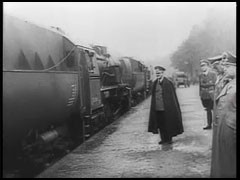
The film "The Nazi Plan" was shown as evidence at the International Military Tribunal in Nuremberg on December 11, 1945. It was compiled for the trial by Budd Schulberg and other US military personnel, under the supervision of Navy Commander James Donovan. The compilers used only German source material, including official newsreels. In this footage titled "Seventh Party Congress 10–16 September 1935," Hermann Göring announces restrictive racial laws.
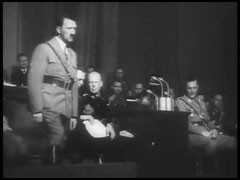
In response to growing international awareness of Nazi atrocities, the Nazis decided to allow a Red Cross investigation committee to visit the Theresienstadt ghetto in Czechoslovakia. Elaborate measures were taken to disguise conditions in the ghetto and to portray an atmosphere of normalcy. This footage, showing an orchestral performance, is part of a German propaganda film made following the Red Cross visit to Theresienstadt.
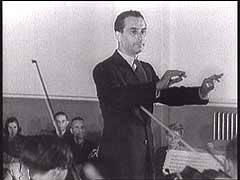
Members of a German Zionist youth group learn farming techniques in preparation for their new lives in Palestine. Many Jewish youths in Nazi Germany participated in similar programs, hoping to escape persecution by leaving the country.
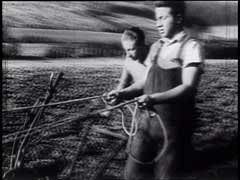
This film clip shows translators in action at the Nuremberg trial. English, French, Russian, and German were the official languages of the Nuremberg trials. Interpreters provided simultaneous translations of the court proceedings which were then available to the trial participants via headphones.
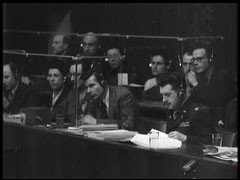
A former US prisoner of war (POW), United States Navy Lieutenant Jack Taylor, testifies to the treatment he and other American POWs received in the Mauthausen concentration camp in Austria.
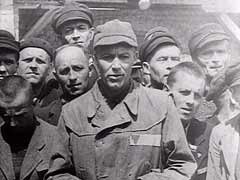
Ion Antonescu governed Romania from 1940 until 1944. Antonescu aligned Romania with the Axis powers in November 1940, and became one of Nazi Germany's closest allies. Romania joined in the German invasion of the Soviet Union in 1941. It also implemented harsh anti-Jewish policies against Jews in Romania. While Antonescu ultimately refused to hand Jews over to the Germans, Romanian forces brutally killed hundreds of thousands of Jews, mainly residents of Bessarabia, Bukovina, and the western Ukraine. As the…
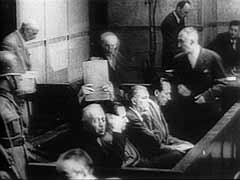
Francois Boix, a concentration camp survivor, testifies about Albert Speer's visit to the Mauthausen concentration camp. Boix identifies Speer by pointing to him in the defendants' dock.
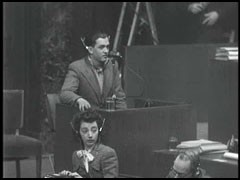
World War II began with the German invasion of Poland in September 1939 and ended in Allied victory in Europe with the German surrender in May 1945. May 8 was proclaimed VE (Victory in Europe) Day. In this footage, United States president Harry S. Truman proclaims victory in Europe and promises to continue the war in the pacific until the unconditional surrender of Japan.
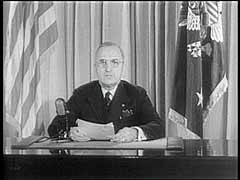
The United Nations Relief and Rehabilitation Administration (UNRRA) was established in November 1943 to aid refugees fleeing Axis aggression. After World War II, UNRRA sought to assist millions of refugees displaced by the war and its consequences. In the aftermath of the war, worldwide food shortages threatened millions with starvation and the world looked to the United States for assistance. In this footage, UNRRA's fourth council meeting convenes in Atlantic City. Director-General Herbert H. Lehman…
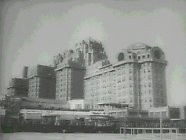
On November 9, 1938, the Nazis led a nationwide pogrom against Jews. During the pogrom, known as "Kristallnacht" (the "Night of Broken Glass"), bands of Storm Troopers (SA) destroyed thousands of Jewish-owned businesses and hundreds of synagogues. Almost 100 Jews were killed in the process. This footage shows scenes from a protest rally in New York City. Rabbi Stephen S. Wise voiced the outrage of the American Jewish community. As part of an official protest by the United States government against the…
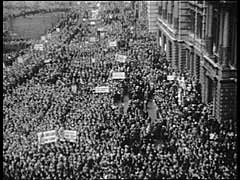
Portion of the speech in which President Franklin D. Roosevelt asked the US Congress to declare war on Japan following the previous day's surprise attack on Pearl Harbor.
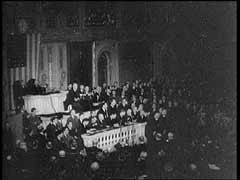
In this footage, General Dwight Eisenhower, General George Patton, and Major General Lewis Craig inspect conditions at the Feldafing displaced persons camp near Wolfratshausen, Germany. Feldafing was one of the first displaced persons camps to house primarily Jewish refugees. In August 1945, Eisenhower ordered that Feldafing be used as a model for the establishment of other camps for Jewish displaced persons in the US occupation zones of Germany and Austria.

In the summer of 1945, representatives of the victorious Allied nations—the United States, Great Britain, France, and the Soviet Union—met in London to discuss the formation of an International Military Tribunal. The questions on the table were daunting: how and where such a court would convene, what the criminal charges would be, and which perpetrators would be put on trial. US President Harry S. Truman issued an executive order designating Supreme Court Justice Robert H. Jackson to be the US…

During World War II , the American Friends Service Committee, a Quaker relief organization, provided food, shelter, and other aid to thousands of Jewish refugees—especially Jewish children—in France. The Quakers were active throughout France, even in areas occupied by German forces. In this footage, Quaker relief workers feed children at one of the Quaker-established schools in Marseille in the unoccupied southern zone of France.
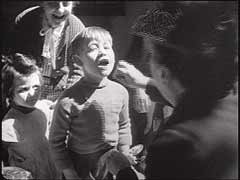
The Dachau concentration camp, northwest of Munich, Germany, was the first regular concentration camp the Nazis established in 1933. About twelve years later, on April 29, 1945, US armed forces liberated the camp. There were some 30,000 starving prisoners in the camp at that time. In this footage, soldiers of the US Seventh Army feed and disinfect survivors of the camp.
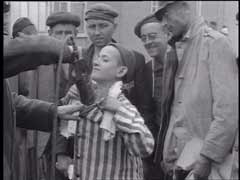
In Nazi usage, "euthanasia" referred to the killing of those whom the Nazis deemed "unworthy of life." In 1941 the Hadamar psychiatric clinic served as one of the euthanasia killing centers in Germany. Patients selected by German doctors for euthanasia were transferred to Hadamar or one of the other facilities and were killed in gas chambers. Over 10,000 people were gassed at Hadamar before the Euthanasia Program officially ended in August 1941. Although the program had officially ended, killings continued…
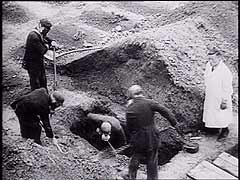
The Ustase were pro-German Croatian fascists. After the Axis invasion and partition of Yugoslavia in April 1941, the Germans established a dependent Croatian state. Led by Ante Pavelic, the Croatian regime began a genocidal campaign against minority groups and killed hundreds of thousands of Serbs and tens of thousands of Jews in Croatia. This possibly staged Ustase footage shows Ustase paramilitary forces rounding up villagers in rural Croatia. In May 1945, Yugoslav partisans under Marshal Tito--with…
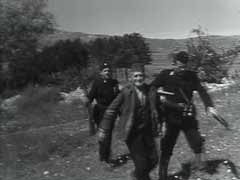
The Medical Case was one of twelve war crimes trials held before an American tribunal as part of the Subsequent Nuremberg Proceedings. The trial dealt with doctors and nurses who had participated in the killing of physically and mentally impaired Germans and who had performed medical experiments on people imprisoned in concentration camps. Sixteen of the defendants were found guilty. Of the sixteen, seven were sentenced to death for planning and carrying out experiments on human beings against their will.…

The Medical Case was one of 12 war crimes trials held before an American tribunal as part of the Subsequent Nuremberg Proceedings. On trial were doctors and nurses who had participated in the killing of physically and mentally impaired Germans and who had performed medical experiments on people imprisoned in concentration camps. Here, concentration camp survivors Maria Kusmierczuk and Jadwiga Dzido, who had been victims of these experiments, show their injuries to the court as evidence.
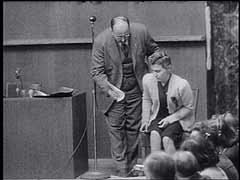
Germany's formal surrender on May 7 and VE-Day (Victory in Europe Day) on May 8, 1945, were marked by joyous celebrations all over Europe. This footage shows streets in Paris and London filled with people celebrating the unconditional Allied victory over Nazi Germany and the winning of the war in Europe.
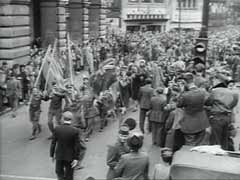
Vidkun Quisling headed the German-controlled government of Norway from 1942-1945. Because of his actions, his name became synonymous with Nazi collaboration.

At the end of World War II, more than three-quarters of the city of Nuremberg, Germany, lay in rubble. This US Army Air Corps color footage shows some of the war damage in Nuremberg, which had been host in the 1920s and 1930s to massive and lavish rallies for the Nazi party.
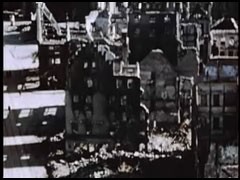
On August 1, 1944, the Armia Krajowa (Polish Home Army) launched an uprising in Warsaw against the German occupiers. Although the Western allies dropped ammunition and supplies and the Soviet army was within sight of the city, the uprising was crushed. This German newsreel footage shows the German suppression of the uprising.
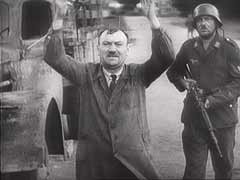
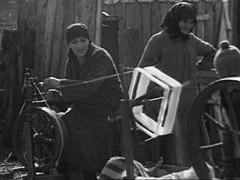
Huge crowds of well wishers gather in the streets on the occasion of the wedding of the Munkács rabbi's 18-year-old daughter, Frime Chaye Rivke. The Grand Rabbi of Munkács (Mukacevo), Chaim Elazar Shapiro, father of the bride, makes a speech in Yiddish exhorting Jews in America to continue to keep Shabbes (to observe the sabbath day). The wedding party then enters the synagogue grounds, and the cantor sings blessings beneath the wedding canopy. The wedding concludes with festive klezmer…
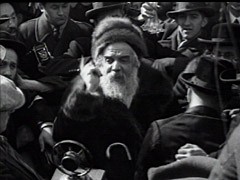
At his hidden headquarters in the mountains of Yugoslavia, Marshal Tito (Josip Broz), head of the Yugoslav Communist partisan movement, prepares his forces for battle. Women gather silk parachutes, used to drop supplies by Allied forces, for use as bandages. Partisans train, preparing to fight the Germans. At the height of the partisan war in Yugoslavia in 1943, Tito's partisans engaged some 35 Axis divisions, which otherwise might have been in service on the Italian or eastern fronts.
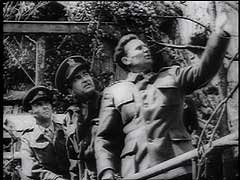
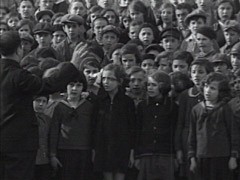
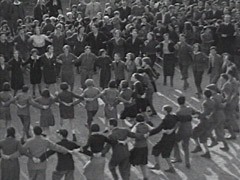
After World War II, the Allies repatriated millions of displaced persons (DPs) to their countries of origin. But hundreds of thousands of people, including more than 250,000 Jewish refugees, could not or would not return. Most Jewish DPs preferred to leave Europe for either Palestine or the United States. The Allies housed them in camps in occupied Germany until they could be resettled. Here, Jewish Zionists protest their continued confinement in Zeilsheim displaced persons camp in Germany. They demand…
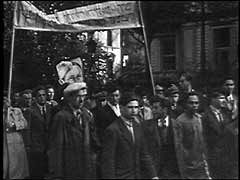
We would like to thank Crown Family Philanthropies, Abe and Ida Cooper Foundation, the Claims Conference, EVZ, and BMF for supporting the ongoing work to create content and resources for the Holocaust Encyclopedia. View the list of donor acknowledgement.